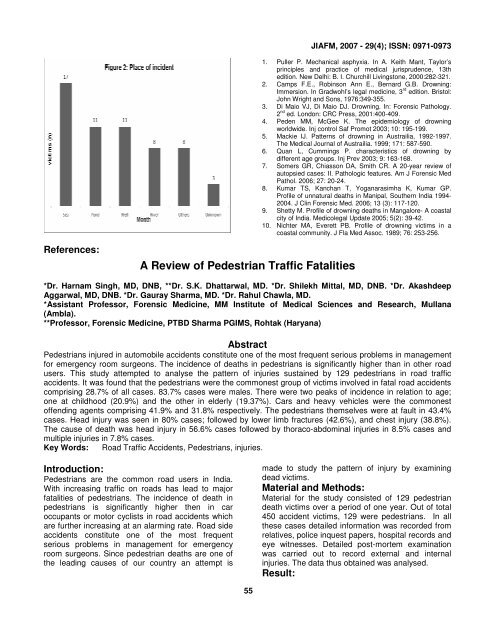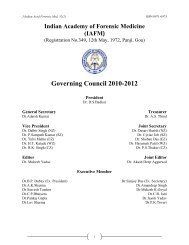Download - forensic medicine
Download - forensic medicine
Download - forensic medicine
You also want an ePaper? Increase the reach of your titles
YUMPU automatically turns print PDFs into web optimized ePapers that Google loves.
JIAFM, 2007 - 29(4); ISSN: 0971-0973<br />
1. Puller P. Mechanical asphyxia. In A. Keith Mant, Taylor’s<br />
principles and practice of medical jurisprudence, 13th<br />
edition. New Delhi: B. I. Churchill Livingstone, 2000:282-321.<br />
2. Camps F.E., Robinson Ann E., Bernard G.B. Drowning:<br />
Immersion. In Gradwohl’s legal <strong>medicine</strong>, 3 rd edition. Bristol:<br />
John Wright and Sons, 1976:349-355.<br />
3. Di Maio VJ, Di Maio DJ. Drowning. In: Forensic Pathology.<br />
2 nd ed. London: CRC Press, 2001:400-409.<br />
4. Peden MM, McGee K. The epidemiology of drowning<br />
worldwide. Inj control Saf Promot 2003; 10: 195-199.<br />
5. Mackie IJ. Patterns of drowning in Austrailia, 1992-1997.<br />
The Medical Journal of Austrailia. 1999; 171: 587-590.<br />
6. Quan L, Cummings P. characteristics of drowning by<br />
different age groups. Inj Prev 2003; 9: 163-168.<br />
7. Somers GR, Chiasson DA, Smith CR. A 20-year review of<br />
autopsied cases: II. Pathologic features. Am J Forensic Med<br />
Pathol. 2006; 27: 20-24.<br />
8. Kumar TS, Kanchan T, Yoganarasimha K, Kumar GP.<br />
Profile of unnatural deaths in Manipal, Southern India 1994-<br />
2004. J Clin Forensic Med. 2006; 13 (3): 117-120.<br />
9. Shetty M. Profile of drowning deaths in Mangalore- A coastal<br />
city of India. Medicolegal Update 2005; 5(2): 39-42.<br />
10. Nichter MA, Everett PB. Profile of drowning victims in a<br />
coastal community. J Fla Med Assoc. 1989; 76: 253-256.<br />
References:<br />
A Review of Pedestrian Traffic Fatalities<br />
*Dr. Harnam Singh, MD, DNB, **Dr. S.K. Dhattarwal, MD. *Dr. Shilekh Mittal, MD, DNB. *Dr. Akashdeep<br />
Aggarwal, MD, DNB. *Dr. Gauray Sharma, MD. *Dr. Rahul Chawla, MD.<br />
*Assistant Professor, Forensic Medicine, MM Institute of Medical Sciences and Research, Mullana<br />
(Ambla).<br />
**Professor, Forensic Medicine, PTBD Sharma PGIMS, Rohtak (Haryana)<br />
Abstract<br />
Pedestrians injured in automobile accidents constitute one of the most frequent serious problems in management<br />
for emergency room surgeons. The incidence of deaths in pedestrians is significantly higher than in other road<br />
users. This study attempted to analyse the pattern of injuries sustained by 129 pedestrians in road traffic<br />
accidents. It was found that the pedestrians were the commonest group of victims involved in fatal road accidents<br />
comprising 28.7% of all cases. 83.7% cases were males. There were two peaks of incidence in relation to age;<br />
one at childhood (20.9%) and the other in elderly (19.37%). Cars and heavy vehicles were the commonest<br />
offending agents comprising 41.9% and 31.8% respectively. The pedestrians themselves were at fault in 43.4%<br />
cases. Head injury was seen in 80% cases; followed by lower limb fractures (42.6%), and chest injury (38.8%).<br />
The cause of death was head injury in 56.6% cases followed by thoraco-abdominal injuries in 8.5% cases and<br />
multiple injuries in 7.8% cases.<br />
Key Words: Road Traffic Accidents, Pedestrians, injuries.<br />
Introduction:<br />
Pedestrians are the common road users in India.<br />
With increasing traffic on roads has lead to major<br />
fatalities of pedestrians. The incidence of death in<br />
pedestrians is significantly higher then in car<br />
occupants or motor cyclists in road accidents which<br />
are further increasing at an alarming rate. Road side<br />
accidents constitute one of the most frequent<br />
serious problems in management for emergency<br />
room surgeons. Since pedestrian deaths are one of<br />
the leading causes of our country an attempt is<br />
made to study the pattern of injury by examining<br />
dead victims.<br />
Material and Methods:<br />
Material for the study consisted of 129 pedestrian<br />
death victims over a period of one year. Out of total<br />
450 accident victims, 129 were pedestrians. In all<br />
these cases detailed information was recorded from<br />
relatives, police inquest papers, hospital records and<br />
eye witnesses. Detailed post-mortem examination<br />
was carried out to record external and internal<br />
injuries. The data thus obtained was analysed.<br />
Result:<br />
55




![syllabus in forensic medicine for m.b.b.s. students in india [pdf]](https://img.yumpu.com/48405011/1/190x245/syllabus-in-forensic-medicine-for-mbbs-students-in-india-pdf.jpg?quality=85)



![SPOTTING IN FORENSIC MEDICINE [pdf]](https://img.yumpu.com/45856557/1/190x245/spotting-in-forensic-medicine-pdf.jpg?quality=85)

![JAFM-33-2, April-June, 2011 [PDF] - forensic medicine](https://img.yumpu.com/43461356/1/190x245/jafm-33-2-april-june-2011-pdf-forensic-medicine.jpg?quality=85)



![JIAFM-33-4, October-December, 2011 [PDF] - forensic medicine](https://img.yumpu.com/31013278/1/190x245/jiafm-33-4-october-december-2011-pdf-forensic-medicine.jpg?quality=85)

